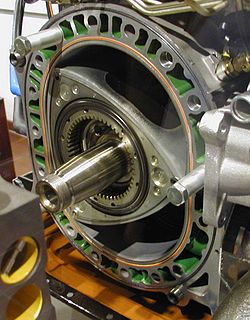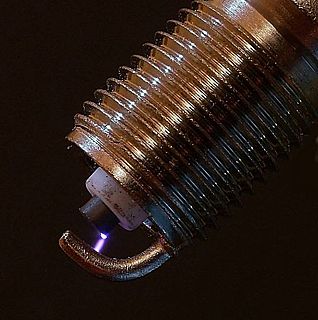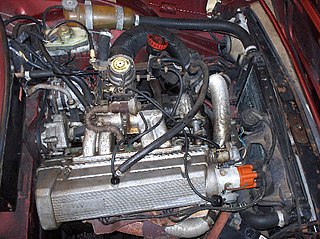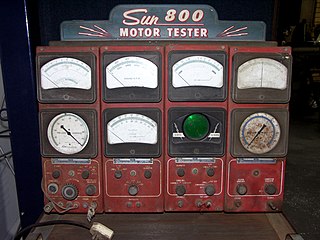
The Wankel engine is a type of internal combustion engine using an eccentric rotary design to convert pressure into rotating motion.

A spark plug is a device for delivering electric current from an ignition system to the combustion chamber of a spark-ignition engine to ignite the compressed fuel/air mixture by an electric spark, while containing combustion pressure within the engine. A spark plug has a metal threaded shell, electrically isolated from a central electrode by a ceramic insulator. The central electrode, which may contain a resistor, is connected by a heavily insulated wire to the output terminal of an ignition coil or magneto. The spark plug's metal shell is screwed into the engine's cylinder head and thus electrically grounded. The central electrode protrudes through the porcelain insulator into the combustion chamber, forming one or more spark gaps between the inner end of the central electrode and usually one or more protuberances or structures attached to the inner end of the threaded shell and designated the side, earth, or ground electrode(s).

In internal combustion engines, exhaust gas recirculation (EGR) is a nitrogen oxide (NO
x) emissions reduction technique used in petrol/gasoline, diesel engines and some hydrogen engines. EGR works by recirculating a portion of an engine's exhaust gas back to the engine cylinders. This dilutes the O2 in the incoming air stream and provides gases inert to combustion to act as absorbents of combustion heat to reduce peak in-cylinder temperatures. NO
x is produced in high temperature mixtures of atmospheric nitrogen and oxygen that occur in the combustion cylinder, and this usually occurs at cylinder peak pressure. Another primary benefit of external EGR valves on a spark ignition engine is an increase in efficiency, as charge dilution allows a larger throttle position and reduces associated pumping losses. Mazda's turbocharged SkyActiv engine uses recirculated and cooled exhaust gases to reduce combustion chamber temperatures, thereby permitting the engine to run at higher boost levels before the air-fuel mixture must be enriched to prevent engine knocking.
A stratified charge engine describes a certain type of internal combustion engine, usually spark ignition (SI) engine that can be used in trucks, automobiles, portable and stationary equipment. The term "stratified charge" refers to the working fluids and fuel vapors entering the cylinder. Usually the fuel is injected into the cylinder or enters as a fuel rich vapor where a spark or other means are used to initiate ignition where the fuel rich zone interacts with the air to promote complete combustion. A stratified charge can allow for slightly higher compression ratios without "knock," and leaner air/fuel ratio than in conventional internal combustion engines.

Engine tuning is the adjustment or modification of the internal combustion engine or Engine Control Unit (ECU) to yield optimal performance and increase the engine's power output, economy, or durability. These goals may be mutually exclusive; an engine may be de-tuned with respect to output power in exchange for better economy or longer engine life due to lessened stress on engine components.
A blow-off valve (BOV), dump valve or compressor bypass valve (CBV) is a pressure release system present in most turbocharged engines. Its main purpose is to take the load off the turbocharger when the throttle is suddenly closed.
An oxygen sensor (or lambda sensor, where lambda refers to air–fuel equivalence ratio, usually denoted by λ) is an electronic device that measures the proportion of oxygen (O2) in the gas or liquid being analysed.

Laser Doppler velocimetry, also known as laser Doppler anemometry, is the technique of using the Doppler shift in a laser beam to measure the velocity in transparent or semi-transparent fluid flows or the linear or vibratory motion of opaque, reflecting surfaces. The measurement with laser Doppler anemometry is absolute and linear with velocity and requires no pre-calibration.
The Trionic 8 is an advanced engine management system in the Trionic series, created by Saab Automobile. It is used in both Saab 9-3 and Opel Vectra vehicles, and is available with 150, 175 and 210 horsepower (160 kW) engines. It will also be used for a flexifuel version starting production spring 2007. Saab Trionic T8 has been developed by Saab and is a very advanced engine management system. The Engine Control Module (ECM) is used principally to regulated the air mass, fuel and ignition timing.
Lean-burn refers to the burning of fuel with an excess of air in an internal combustion engine. In lean-burn engines the air:fuel ratio may be as lean as 65:1. The air / fuel ratio needed to stoichiometrically combust gasoline, by contrast, is 14.64:1. The excess of air in a lean-burn engine emits far less hydrocarbons. High air–fuel ratios can also be used to reduce losses caused by other engine power management systems such as throttling losses.
Homogeneous Charge Compression Ignition (HCCI) is a form of internal combustion in which well-mixed fuel and oxidizer are compressed to the point of auto-ignition. As in other forms of combustion, this exothermic reaction releases energy that can be transformed in an engine into work and heat.

An engine control unit (ECU), also commonly called an engine control module (ECM) is a type of electronic control unit that controls a series of actuators on an internal combustion engine to ensure optimal engine performance. It does this by reading values from a multitude of sensors within the engine bay, interpreting the data using multidimensional performance maps, and adjusting the engine actuators. Before ECUs, air–fuel mixture, ignition timing, and idle speed were mechanically set and dynamically controlled by mechanical and pneumatic means.

A diesel particulate filter (DPF) is a device designed to remove diesel particulate matter or soot from the exhaust gas of a diesel engine.

An air flow meter is a device that measures air flow, i.e. how much air is flowing through a tube. It does not measure the volume of the air passing through the tube, it measures the mass of air flowing through the device per unit time. Thus air flow meters are simply an application of mass flow meters for a special medium. Typically, mass air flow measurements are expressed in the units of kilograms per second (kg/s).

In a spark ignition internal combustion engine, Ignition timing refers to the timing, relative to the current piston position and crankshaft angle, of the release of a spark in the combustion chamber near the end of the compression stroke.
Trionic T5.5 is an engine management system in the Saab Trionic range. It controls ignition, fuel injection and turbo boost pressure. The system was introduced in the 1993 Saab 9000 2.3 Turbo with B234L and B234R engine.
Trionic is an engine management system developed by Saab Automobile, consisting of an engine control unit (ECU) that controls 3 engine aspects:
- Ignition timing,
- Fuel injection
- Acts as a boost controller.

The SRM Engine Suite is an engineering software tool used for simulating fuels, combustion and exhaust gas emissions in internal combustion engine applications. It is used worldwide by leading IC engine development organisations and fuel companies. The software is developed, maintained and supported by CMCL Innovations, Cambridge, U.K.

An internal combustion engine (ICE) is a heat engine in which the combustion of a fuel occurs with an oxidizer in a combustion chamber that is an integral part of the working fluid flow circuit. In an internal combustion engine, the expansion of the high-temperature and high-pressure gases produced by combustion applies direct force to some component of the engine. The force is applied typically to pistons, turbine blades, a rotor, or a nozzle. This force moves the component over a distance, transforming chemical energy into useful work. This replaced the external combustion engine for applications where weight or size of the engine is important.

An exhaust gas analyser or exhaust carbon monoxide (CO) analyser is an instrument for the measurement of carbon monoxide among other gases in the exhaust, caused by an incorrect combustion, the Lambda coefficient measurement is the most common.














